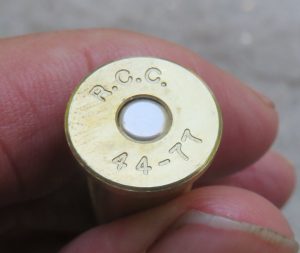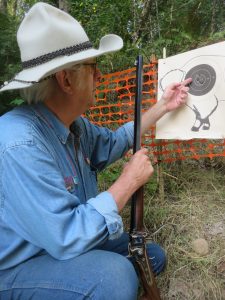By Mike Nesbitt
In the realm of cartridge brass production, Roberson Cartridge Company is really a new kid on the block but they’re going for it in a very big way.

A new Roberson .44/77 case (shown with paper patched bullet) on the cotton bag.
They have a line-up of cases, either available or will be available, for a long line of calibers. Some of those cases are for cartridges that you simply don’t see every day such as the big African express loads or for the old Sharps cartridges. I can say that some of those cartridge cases will be very welcome by black powder shooters and reloaders. I’m not saying this too early because I just got some of their brass for the .44/77 (plus some for the .44/90) and from what I see, I’m already impressed.
At the Matthew Quigley Buffalo Rifle Match last June, Jeff Roberson (the boss) and his chief engineer were both there and we had the opportunity to talk about brass, ammo, shooting, and most everything. It was then that I knew I wanted to try some of their new brass, which is lathe-turned instead of drawn. It wasn’t too long after I got home that a package from Roberson was delivered and I got my first experiences with the new brass.
The brass for the .44/77 Sharps got my attention first. Those 10 cartridge cases came in a white cotton drawstring bag with “Roberson Cartridge Company” stenciled on the front. My first step was to measure the thickness of the rims and that, with my micrometer, came out at .070” or just slightly thinner than the Jamison brass that I’m already using in my Model 1874 rifle by C. Sharps Arms. Next, just so there should be no surprises further down the trail, I chambered a couple of the new empty cases in my rifle. No problems there.

The Roberson headstamp for the .44/77 Sharps.
Then one of the new empty .44/77 cases was weighed and that one balanced the scale at 217.5 grains. An unfired Jamison cases was also weighed just for comparison and it was four grains heavier, 221.5 grains. Please note, those were not average weights, only the weights of the two individual cases, both selected at random. Actually, they were pretty close.
Following that, the new cases were all run through my RCBS sizing die just to make sure. Then they were checked for length in my file trim die. Again, no problems, they all “measured up” very nicely. Next, they were expanded and primed. The primer pockets seemed to be just a little tight, guessing from how the primers popped in, but again, no problems. (Maybe I was just being a little too cautious because the “tight primer pockets” did not feel tight again for the 2nd loading.)
That first loading used a bullet and powder charge that was somewhat similar to the original Sharps load for the .44-2 ¼” case, using 71 grains of Olde Eynsford 1 1/2F. That powder, plus an .060” Walters wad, went under a 415-grain bullet cast from my favorite Brooks “Tru-Bore” mold. For ignition, CCI large rifle magnum primers were used. That, in my opinion, made a good starting load for the new brass cases. It is a load I have used before and it would be tried at just 50 yards.
Those fired just fine, at least as good as we might expect. Then the brass was cleaned before being resized and check again for length. No stretching. For the second load, the same Brooks bullet was used over 72 grains of Olde Eynsford 2F which increases the pressure.
After the second firing, the necks of the cases were annealed. That made a real difference in the sizing and expanding of the cases as well as the seating of the bullets. Much nicer. And the third loading was taken to the range and fired for a group which was very good, still shooting at just 50 yards and with a blade front sight. And still, no stretching of the new cases was detected.

Mike checks a 5-shot group fired with the new brass in the Sharps rifle.
Now those cases have been fired four times and loaded five times with still no sign of any stretching. I talked with Roberson about that and he gave me some interesting information about the brass used for their cases.
“When we got into this business,” he recalled, “we discovered that most drawn brass has a small percentage of lead in it so that it doesn’t get too hard during the draw process. Normally, it is annealed after each draw and during the production cycle cases will be annealed 4-6 times depending on the caliber being manufactured. Typically, when the cylinder is formed it goes through 4 draws and is annealed each time. The annealing alters the molecular structure of the brass and most manufactures allow the brass to cool at room temperature. So, we’ve discovered this will allow for variances in the case head hardness and allows for higher percentage of failure in the primer pocket after a few firings.
“We had C2600 (70% copper and 30% zinc) made into rod for us,” Roberson continued. “It is hammer forged into a tight molecular structure and that gives us better head strength and longer life span under normal pressures. I think SAAMI’s top pressure is 65,000 PSI, but it could be more. Then we had 15% malleability designed into the brass for expansion and contraction and that gives us some really good brass. Black powder shooters should get a lot of reloads per case. We’ve tested our brass with a .40-90 Sharps and put 100 rounds through one case without any issues.

Another group, 10 shots this time, fired with loads in the Roberson brass.
“Our method is unique,” he explained, “in that we use CNC lathes and mills to manufacture our cases versus a draw process. This allows us to manufacture low volume runs of a lot of different calibers. Our business model is to manufacture low volume runs of vintage, obsolete, hard to find and wildcat calibers for customers.”
I’m not going to try shooting these cases 100 times before finishing this report. Besides, I’m already very pleased with the new Roberson cases. Compared to other brass cartridge cases, the Roberson brass is costly but they do have a long list of available cartridges that others do not make.
The .44/77 Sharps is just one example of those hard to find calibers and Roberson makes those with two different headstamps. In fact, custom headstamps are available. These .44/77 cases are priced at $7.51 each. Go to www.rccbrass.com to see what they have to offer. I sure like these .44/77s and I haven’t even tried their brass for the .44/90 Sharps yet, but I will…



